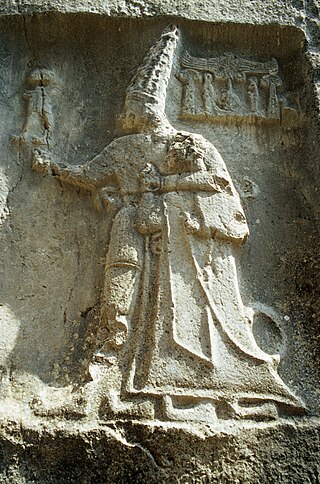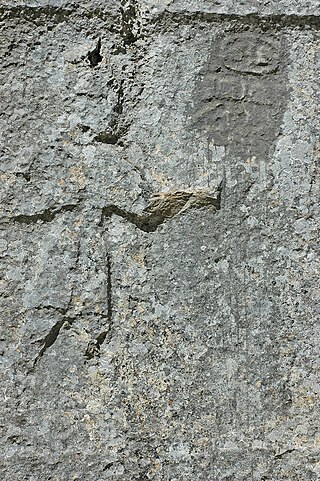Related Research Articles

Ugarit was an ancient Canaanite port city in northern Syria, in the outskirts of modern Latakia. It was discovered by accident in 1928 with the Ugaritic texts. Its ruins are often called Ras Shamra after the headland where they lie.
Ugaritic is an extinct Northwest Semitic language, classified by some as a dialect of the Amorite language. It is known through the Ugaritic texts discovered by French archaeologists in 1929 at Ugarit, including several major literary texts, notably the Baal cycle. It has been used by scholars of the Hebrew Bible to clarify Biblical Hebrew texts and has revealed ways in which the cultures of ancient Israel and Judah found parallels in the neighboring cultures.

The Ugaritic writing system is a Cuneiform Abjad with syllabic elements used from around either 1400 BCE or 1300 BCE for Ugaritic, an extinct Northwest Semitic language, and discovered in Ugarit, Syria, in 1928. It has 30 letters. Other languages were occasionally written in the Ugaritic script in the area around Ugarit, although not elsewhere.

Cuneiform is a logo-syllabic writing system that was used to write several languages of the Ancient Near East. The script was in active use from the early Bronze Age until the beginning of the Common Era. Cuneiform scripts are marked by and named for the characteristic wedge-shaped impressions which form their signs. Cuneiform is the earliest known writing system and was originally developed to write the Sumerian language of southern Mesopotamia.

Astarte is the Hellenized form of the Ancient Near Eastern goddess ʿAṯtart. ʿAṯtart was the Northwest Semitic equivalent of the East Semitic goddess Ishtar.

Anat, Anatu, classically Anath was a goddess associated with warfare and hunting, best known from the Ugaritic texts. Most researchers assume that she originated in the Amorite culture of Bronze Age upper Mesopotamia, and that the goddess Ḫanat, attested in the texts from Mari and worshiped in a city sharing her name located in Suhum, should be considered her forerunner.

Šarruma, also romanized as Šarrumma or Sharruma, was a Hurrian god. He could be depicted in both anthropomorphic form, sometimes riding on the back of a leopard, and in the theriomorphic form as a bull. His character is not fully understood, though it is known that he could function as a mountain god. He was regarded as a son of Ḫepat and Teshub. He was also linked to various moon deities. Additionally, the only mythological text he appears in addresses him as a messenger (sukkalu) of Kumarbi. He was worshiped by Hurrians in southeastern Anatolia and northern Syria, for example in Kummanni and Lawazantiya in Kizzuwatna. From this kingdom he was introduced to the Hittite pantheon as well. Hittite influence in turn resulted in his introduction to cities such as Aleppo, Emar and Ugarit. He was also venerated in Luwian religion in the first millennium BCE, with theophoric names invoking him attested from as late as the Hellenistic period in Cilicia and Lycia.
Yam was a god representing the sea and other sources of water worshiped in various locations on the eastern Mediterranean coast, as well as further inland in modern Syria. He is best known from the Ugaritic texts. While he was a minor deity in Ugaritic religion, he is nonetheless attested as a recipient of offerings, and a number of theophoric names invoking him have been identified. He also played a role in Ugaritic mythology. In the Baal Cycle he is portrayed as an enemy of the weather god, Baal. Their struggle revolves around attaining the rank of the king of the gods. The narrative portrays Yam as the candidate favored by the senior god El, though ultimately it is Baal who emerges victorious. Yam nonetheless continues to be referenced through the story after his defeat. In texts from other archaeological sites in Syria, attestations of Yam are largely limited to theophoric names. In Emar he was among the many deities venerated during a local festival, zukru, which took place once every seven years.
Yarikh, or Yaraḫum, was a moon god worshiped in the Ancient Near East. He is best attested in sources from the Amorite city of Ugarit in the north of modern Syria, where he was one of the principal deities. His primary cult center was most likely Larugadu, located further east in the proximity of Ebla. His mythic cult center is Abiluma. He is also attested in other areas inhabited by Amorites, for example in Mari, but also in Mesopotamia as far east as Eshnunna. In the Ugaritic texts, Yarikh appears both in strictly religious context, in rituals and offering lists, and in narrative compositions. He is the main character in The Marriage of Nikkal and Yarikh, a myth possibly based on an earlier Hurrian composition. The eponymous goddess was regarded as his wife in Ugarit, but she is not attested in documents from most other Syrian cities, and most likely only entered the Ugaritic pantheon due to the influence of Hurrian religion.

The Canaanite religion was the group of ancient Semitic religions practiced by the Canaanites living in the ancient Levant from at least the early Bronze Age to the first centuries CE. Canaanite religion was polytheistic and, in some cases, monolatristic.
Sons of God is a phrase used in the Tanakh or Old Testament and in Christian Apocrypha. The phrase is also used in Kabbalah where bene elohim are part of different Jewish angelic hierarchies.

Old Persian cuneiform is a semi-alphabetic cuneiform script that was the primary script for Old Persian. Texts written in this cuneiform have been found in Iran, Armenia, Romania (Gherla), Turkey, and along the Suez Canal. They were mostly inscriptions from the time period of Darius I, such as the DNa inscription, as well as his son, Xerxes I. Later kings down to Artaxerxes III used more recent forms of the language classified as "pre-Middle Persian".
Shapshu or Shapsh, and also Shamshu, was a Canaanite sun goddess. She also served as the royal messenger of the high god El, her probable father. Her most common epithets in the Ugaritic corpus are nrt ỉlm špš, rbt špš, and špš ʿlm. In the pantheon lists KTU 1.118 and 1.148, Shapshu is equated with the Akkadian dšamaš.

The Legend of Keret, also known as the Epic of Kirta, is an ancient Ugaritic epic poem, dated to Late Bronze Age, circa 1500 – 1200 BCE. It recounts the myth of King Kirta of Hubur. It is one of the Ugaritic texts.
The Urra=hubullu is a major Babylonian glossary or "encyclopedia". It consists of Sumerian and Akkadian lexical lists ordered by topic. The canonical version extends to 24 tablets, and contains almost 10,000 words. The conventional title is the first gloss, ur5-ra and ḫubullu meaning "interest-bearing debt" in Sumerian and Akkadian, respectively. One bilingual version from Ugarit [RS2.(23)+] is Sumerian/Hurrian rather than Sumerian/Akkadian.
Ancient Near East studies is the field of academic study of the ancient Near East (ANE). As such it is an umbrella term for Assyriology, in some cases extending to Egyptology.

The Hurrian songs are a collection of music inscribed in cuneiform on clay tablets excavated from the ancient Amorite-Canaanite city of Ugarit, a headland in northern Syria, which date to approximately 1400 BC. One of these tablets, which is nearly complete, contains the Hurrian Hymn to Nikkal, making it the oldest surviving substantially complete work of notated music in the world. While the composers' names of some of the fragmentary pieces are known, h.6 is an anonymous work.

The Ugaritic texts are a corpus of ancient cuneiform texts discovered since 1928 in Ugarit and Ras Ibn Hani in Syria, and written in Ugaritic, an otherwise unknown Northwest Semitic language. Approximately 1,500 texts and fragments have been found to date. The texts were written in the 13th and 12th centuries BC.

Nupatik, in early sources known as Lubadag, was a Hurrian god of uncertain character. He is attested in the earliest inscriptions from Urkesh, as well as in texts from other Hurrian settlements and Ugarit. He was also incorporated into Hittite religion. A similarly named deity continued to be venerated in Arbela as late as in the Neo-Assyrian period.

Hauron, Haurun or Hawran was an ancient Egyptian god worshiped in Giza. He was closely associated with Harmachis, with the names in some cases used interchangeably, and his name as a result could be used as a designation of the Great Sphinx of Giza. While Egyptologists were familiar with Hauron since the nineteenth century, his origin was initially unknown, and only in the 1930s it was established that he originated outside Egypt. Today it is agreed that he was the Egyptian form of a god worshiped in Canaan and further north in the city of Ugarit, conventionally referred to as Horon in scholarship.
References
- ↑ Johannes Cornelis de Moor, "An Anthology of religious texts from Ugarit" (1987), p. 309, in KTU M. Dietrich, O. Loretz, J. Sanmartin, Die keil-alphabetischen Texte aus Ugarit, Band 1 (Neukirchen 1976).
- ↑ Sarah Iles Johnston Religions of the ancient world: a guide 2004 p697 "CAT M. Dietrich, O. Loretz, and J. Sanmartin, The Cuneiform Alphabetic Texts from Ugarit, Ras Ihn Hani, and Other Places (Münster: Ugarit-Verlag, 1995) (= second edition of KTU)"